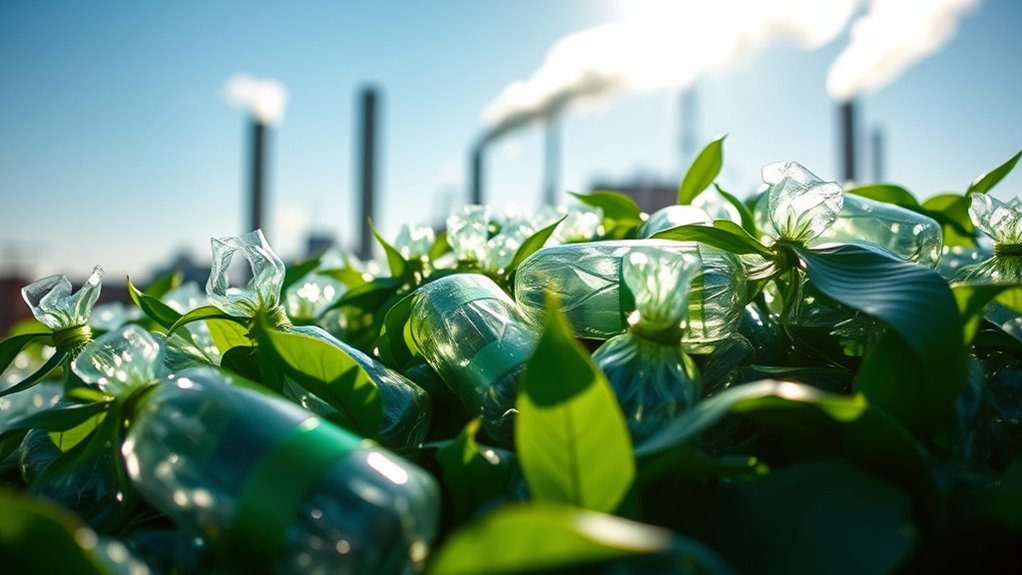Recycled polyester (rPET) is often marketed as a green alternative to virgin polyester, but its sustainability hinges on how it’s produced. If made using energy-efficient and eco-conscious methods, it can reduce waste and conserve resources. However, some processes are energy-intensive and may cause microplastic pollution, making the eco-friendly claims questionable. To truly understand its impact, it’s important to know about manufacturing practices and certifications—consider exploring further for a clearer picture.
Key Takeaways
- The environmental benefits of rPET depend on sustainable manufacturing practices, not just recycling labels.
- Some production methods are energy-intensive, which can negate the eco-friendly claims of recycled polyester.
- Transparency, certifications, and eco-conscious processes are essential to distinguish genuine sustainability from greenwashing.
- Consumer awareness and demand for responsible production can incentivize brands to adopt more eco-friendly practices.
- rPET is a valuable tool for sustainability but is not inherently a fully green solution without responsible manufacturing.

Have you ever wondered how your favorite clothing scraps can be transformed into new, eco-friendly fabrics? That’s the core idea behind recycled polyester, or rPET. This material is touted as a sustainable alternative to virgin polyester, made from post-consumer plastic bottles and textile waste. The process of turning discarded plastics into fabric aims to close the loop in fashion production, reducing waste and conserving resources. But despite its eco-friendly claims, the story isn’t so straightforward. The success of recycled polyester hinges on sustainable manufacturing practices and how consumers perceive this material. Many see it as a step forward, a way to lessen environmental impact. Others remain skeptical, questioning whether it truly offers a green solution or if it’s just greenwashing designed to boost sales.
Recycled polyester transforms waste into eco-friendly fabric, but its true sustainability depends on manufacturing practices and consumer awareness.
Sustainable manufacturing is key. When producers use energy-efficient methods and eco-conscious chemicals in creating rPET, it becomes more than just recycled plastic; it turns into a genuinely sustainable product. However, not all manufacturing processes are equal. Some companies cut corners, using energy-intensive methods that negate the environmental benefits. This inconsistency influences consumer perception profoundly. When consumers learn that some brands might be engaging in superficial eco-labeling without meaningful environmental efforts, trust diminishes. Conversely, transparent practices and certifications that verify sustainable manufacturing can boost confidence and promote a more positive perception of recycled polyester. Sustainable manufacturing practices are essential for ensuring the genuine environmental benefits of rPET.
Your perception as a consumer shapes the market’s direction. When you actively seek out and support brands that prioritize genuine sustainability, you encourage better manufacturing practices. If you’re aware of the complexities behind recycled polyester, you might be more critical of claims that paint it as an entirely green solution. Instead, you recognize that while rPET reduces plastic waste and saves resources, it’s also essential to think about factors like microplastic shedding during washing, the energy needed for production, and the lifecycle of the end product. Your choices influence brands to improve transparency and adopt truly sustainable manufacturing methods.
In the end, recycled polyester isn’t inherently good or bad. It’s a tool that, when used responsibly, can help address environmental issues. But it’s up to you to question the narratives, scrutinize the claims, and support transparent brands committed to genuine sustainability. Your perception and purchasing decisions can drive the industry toward more honest practices, making recycled polyester a true green solution rather than just a marketing gimmick. By staying informed and mindful, you contribute to a more sustainable future—one fabric scrap at a time.
Frequently Asked Questions
How Does Rpet Impact Overall Plastic Waste Reduction?
You can reduce plastic waste markedly with rPET because it transforms used bottles into new fibers, lowering landfill accumulation. By choosing products made from recycled polyester, you help lessen the environmental impact of plastic pollution. However, it’s crucial to take into account the entire lifecycle, as some argue that increased demand for rPET may encourage more plastic production. Overall, rPET positively impacts plastic waste reduction when paired with responsible consumption.
Are There Health Concerns Associated With Rpet Fibers?
You should be aware that there are some health risks associated with rPET fibers due to chemical exposure. During manufacturing, certain chemicals used can linger on the fibers, potentially causing skin irritation or respiratory issues if you’re sensitive. However, many manufacturers now follow strict safety standards to minimize these risks. Still, it’s smart to stay informed about the origin of your rPET products and verify they meet safety certifications.
What Are the Economic Costs of Switching to Rpet?
Switching to rPET can be a double-edged sword financially. The cost analysis shows higher initial investment in equipment and supply chain adjustments, impacting your budget. However, embracing rPET boosts market viability by appealing to eco-conscious consumers, potentially increasing sales. While it may seem like a tall order, the long-term savings and reputation benefits often outweigh the upfront costs, making it a worthwhile gamble for your brand’s future.
How Recyclable Is Rpet at the End of Its Lifecycle?
You can recycle rPET at the end of its lifecycle, but recycling challenges remain. The fiber’s durability helps it withstand multiple recycling processes, yet contamination and fiber degradation can hinder recycling efficiency. While technically recyclable, the quality of recycled rPET may decline over time, making it less ideal for certain applications. Proper collection and processing are vital to maximize its recyclability and guarantee it truly contributes to a circular economy.
Does Rpet Production Release Any Harmful Chemicals?
Imagine a factory where fibers are spun from plastic bottles—you wonder if harmful chemicals are released. In production, chemical safety is a concern; some processes emit manufacturing emissions that can contain toxins. However, many manufacturers now adopt safer techniques to minimize chemical risks. While rPET can release chemicals during manufacturing, improved regulations and greener practices help reduce potential harm, making it a safer choice for eco-conscious consumers.
Conclusion
As you consider recycled polyester, remember that over 60 million tons of plastic waste end up in oceans each year, much of which becomes rPET. While it reduces reliance on virgin resources, it’s not a perfect solution—some argue it still sheds microplastics and encourages fast fashion. So, before you buy, ask yourself if choosing rPET is truly a step toward sustainability or just greenwashing. Your choices can make a real difference.










